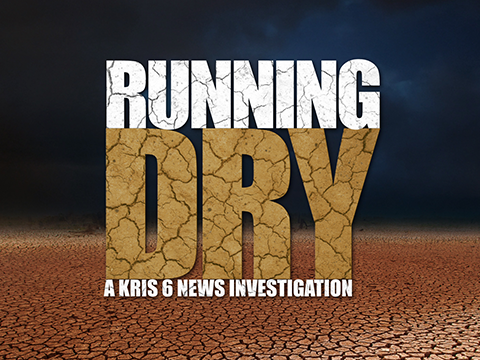PADRE ISLAND, Texas — When traveling to the beach, it is important to know about the conditions of the water to ensure you, and everyone you are visiting with, stays safe.
At every beach, there is a flag-warning system, which indicates the level of risk associated with swimming on that part of the shore. Most beaches across the country have flags showing the level of rip current: Green means conditions are calm, yellow means the water is calm or moderate, red means conditions are dangerous and swimmers should not go any deeper than into waist-deep water. Beaches in the Coastal Bend also have purple and orange flags: Purple means venomous marine life is present, and orange indicates an environmental warning for air and/or water quality.
Monday’s conditions at J.P. Luby Beach on Padre Island called for a red flag, meaning swimming was not advised.
One person who is aware of how dangerous rip currents can be is Chuck Smith, who was surfing at the beach Monday. Smith is a former Marine Corps combat water-safety instructor. When Smith was in boot camp in San Diego, he said he trained in rip currents in the Pacific Ocean.
“They would find rip currents, really strong ones, and put us in there with boats, and lifeguards, things like that, and teach us what to do," he said. "Those were strong rip currents, but they’re nothing compared to here: These rip currents are brutal."
Smith has lived in Corpus Christi for six years, and has lived in multiple coastal cities in his life. He said the Gulf Coast waters are some of the toughest for swimming that he has experienced in his life, and he even had to help his father out of the water recently.
“About a year ago, my dad was not even waist-high, and he couldn’t make it out," he said. "He got to the wrong spot, and he had to go get him."
Other J.P. Luby beachgoers were not as knowledgeable about rip currents as Smith.
Darian Ronje and Madison Cade have lived in Corpus Christi their whole lives, and they don’t know specifics about the flag-warning system at local beaches.
“It’s common sense I guess, like green means go ahead, yellow is like ‘eh,’ red is like, ‘stay away,’” Ronje said.
“I know it’s red flag, and not to go in far, just knee-height,” Cade said.
Ronje was with her young daughter, who had a life vest on while playing along the shoreline. She said she is extra-cautious when it comes to her children because of instances of people drowning at local beaches.
“It’s just kind of scared me, to stay away from the water,” she said. "I don’t want them to drown or anything.”
Ronje said she would like to learn more about rip-current dangers, and the flag-warning system. One local organization that helps with education and awareness is the Je’Sani Smith Foundation, an organization founded in honor of a King High School student who drowned in 2019.
The group's Director of Marketing Lucy Kernan said the organization emphasizes three points for awareness of rip currents.
“Number One is: check the beach flags," she said. "If there is a red flag flying, that means it is not safe to swim there. Swim near lifeguards, if you can see a lifeguard, they are more likely to see you if you get into trouble. The third thing we like to teach to members of the public is to avoid swimming near piers and jetties -- that is where rip currents form on our local beaches."
Kernan said people should check the conditions of the water before they head to the beach. The National Weather Service and City of Corpus Christi post updates of water conditions daily.
“I cannot stress the importance of educating and your loved ones about beach safety and rip currents, because our main goal is to reduce accidents, and prevent deaths,” she said.
Being prepared can save a life. Visit Corpus Christi has tips to ensure a safe visit to local beaches.




